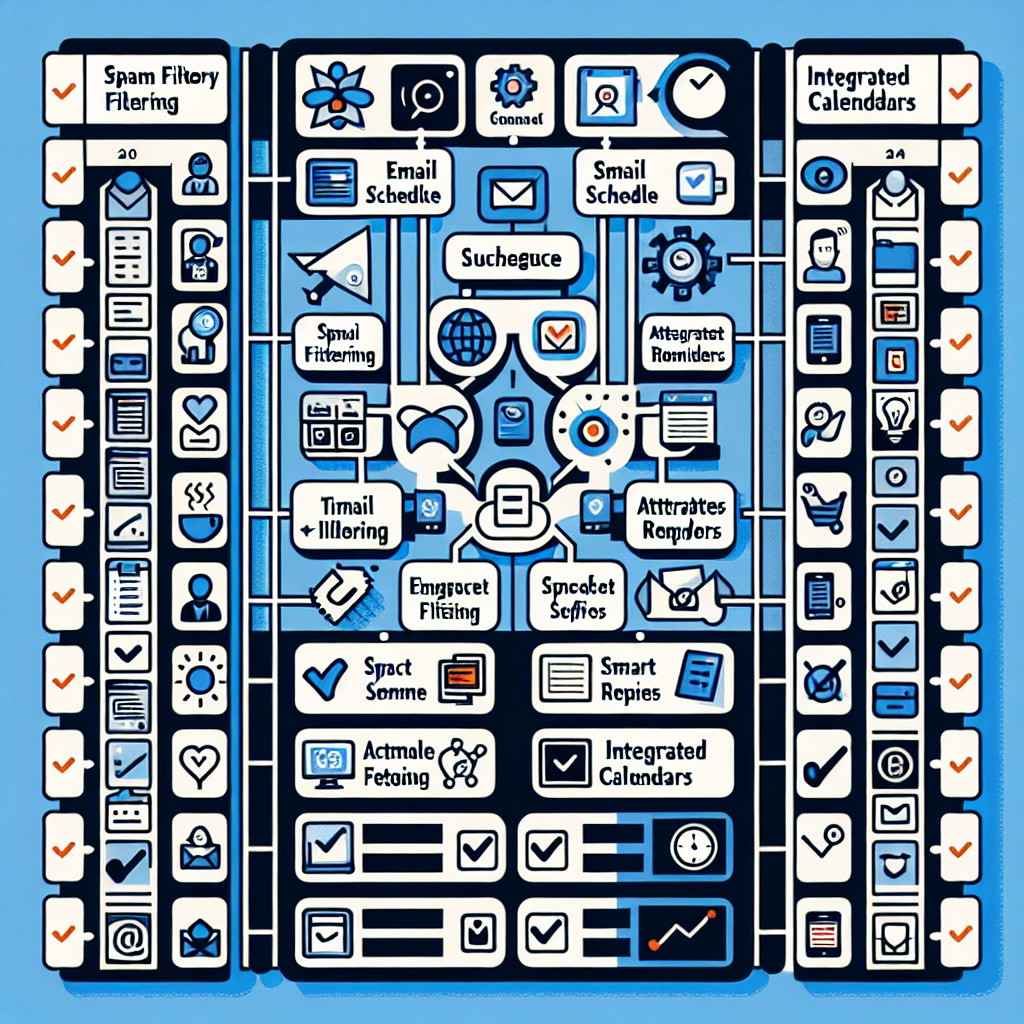In the digital age, email remains a vital communication tool. It's a lifeline for businesses, professionals, and individuals alike.
Yet, managing a bustling inbox can be a daunting task. It's easy to get overwhelmed by the sheer volume of emails.
Enter email productivity tools. These software solutions promise to streamline your email management, enhancing productivity.
But with a plethora of options available, how do you choose the right one? What features should you look for? How can these tools truly boost your productivity?
This comprehensive guide aims to answer these questions. We delve into the world of email productivity tools, exploring their features, benefits, and impact on workflow.
Whether you're a professional drowning in emails or a business owner seeking efficiency, this guide is for you. Let's embark on this journey to better email management and enhanced productivity.
The Importance of Email Productivity in the Modern Workplace
In today's fast-paced work environment, email is more than just a communication tool. It's a hub for collaboration, information exchange, and task management.
However, without effective management, email can become a productivity sinkhole. A cluttered inbox can lead to missed messages, overlooked tasks, and increased stress levels.
That's where email productivity tools come into play. They help streamline email management, reducing clutter and enhancing efficiency. With the right tool, you can transform your inbox from a source of stress into a productivity powerhouse.
Defining Email Productivity Tools and Their Impact on Workflow
Email productivity tools are software applications designed to enhance the efficiency and effectiveness of email management. They offer features like smart sorting, automated responses, and task integration, among others. These tools aim to reduce the time spent on email-related tasks, allowing users to focus on more critical aspects of their work.
The impact of these tools on workflow is significant. By automating routine tasks and organizing emails more effectively, they can drastically reduce the time spent managing emails. This leads to a smoother, more efficient workflow, with less time wasted on email management and more time available for productive work.
Moreover, these tools can also help reduce the stress associated with managing a cluttered inbox. By keeping your inbox organized and manageable, they can contribute to a more focused and less stressful work environment.
Evaluating the Features of Top Email Productivity Tools
When choosing an email productivity tool, it's crucial to consider its features. The best tools offer a range of features designed to streamline email management and enhance productivity. These features can vary widely from one tool to another, but some are common across most high-quality tools.
Some of the key features to look for in an email productivity tool include:
- Smart sorting and filtering
- Automated responses
- Task integration
- Calendar integration
- Mobile access
- Cross-platform compatibility
- Security features
- Integration with other software
User Interface and Ease of Use
The user interface of an email productivity tool plays a significant role in its effectiveness. A tool with a complex, confusing interface can be more of a hindrance than a help. On the other hand, a tool with a simple, intuitive interface can significantly enhance productivity.
Ease of use is another critical factor. The best tools are those that are easy to use, even for those with little technical expertise. They should be straightforward to set up and use, with clear instructions and helpful tutorials available.
Security Features
Security is a crucial consideration when choosing an email productivity tool. The tool should offer robust security features to protect your emails and other data. This includes encryption, two-factor authentication, and other security measures.
In addition, the tool should comply with all relevant privacy regulations. This includes GDPR for users in the European Union, as well as other regional and industry-specific regulations.
Integration with Other Software
Finally, consider how well the tool integrates with other software. The best email productivity tools can seamlessly integrate with a range of other productivity software. This includes task management tools, calendar apps, and CRM systems, among others.
This integration can significantly enhance productivity by allowing you to manage all aspects of your workflow from a single platform. It can also reduce the risk of errors and oversights by ensuring that all your tools are working together seamlessly.
AI and Machine Learning in Email Organization
Artificial Intelligence (AI) and machine learning are revolutionizing email organization. These technologies can automate many of the tasks involved in managing emails, freeing up time for more important work.
AI can sort and categorize emails based on their content and importance. It can also suggest responses, schedule emails to be sent at optimal times, and even write emails for you. Machine learning, on the other hand, can learn from your email habits and preferences to improve its performance over time.
These technologies are not just for large corporations. Many email productivity tools now offer AI and machine learning features that are accessible and affordable for individuals and small businesses. By leveraging these technologies, you can significantly enhance your email productivity and reduce the time and stress involved in managing your inbox.
The Cost-Benefit Analysis of Premium vs. Free Tools
When it comes to email productivity tools, there's a wide range of options. Some are free, while others require a monthly or annual subscription. The choice between free and premium tools often comes down to a cost-benefit analysis.
Free tools can be a great starting point, especially for individuals or small businesses on a tight budget. They often offer basic features that can significantly improve email management. However, they may lack advanced features, customer support, or the capacity to handle a large volume of emails.
Premium tools, on the other hand, typically offer more advanced features and capabilities. These may include:
- Advanced AI and machine learning capabilities
- Enhanced security features
- Integration with other productivity software
- Superior customer support
- Capacity to handle a large volume of emails
While premium tools come at a cost, they can provide significant value in terms of time saved and productivity gained. It's important to consider not just the upfront cost, but also the potential return on investment. A tool that saves you several hours each week could easily pay for itself in terms of increased productivity.
User Reviews and Testimonials: Real-World Effectiveness
User reviews and testimonials can provide valuable insights into the real-world effectiveness of email productivity tools. They offer a glimpse into how these tools perform in various contexts, from small businesses to large corporations, and across different industries.
While every user's experience is unique, patterns can emerge from these reviews. For instance, a tool that consistently receives praise for its user-friendly interface or robust security features is likely to excel in these areas. On the other hand, frequent complaints about poor customer support or technical glitches can be a red flag.
However, it's important to approach reviews with a critical eye. Some may be biased or lack context. Always consider the source of the review and whether the user's needs and circumstances align with your own. This will help you make an informed decision about which email productivity tool is right for you.
Case Studies: Time Saved and Productivity Gains
Case studies offer concrete examples of how email productivity tools can save time and boost productivity. They provide quantifiable evidence of the benefits these tools can bring to individuals and organizations. For instance, a case study might detail how a company reduced its email processing time by 50% after implementing a specific tool.
Another case study might focus on an individual who was able to reclaim several hours each week by using an email productivity tool to automate routine tasks. These real-world examples can help potential users understand the tangible benefits of these tools, beyond the abstract concept of "increased productivity."
However, it's important to remember that results can vary based on numerous factors, including the user's email volume, their familiarity with the tool, and their specific workflow needs. Therefore, while case studies can be informative, they should not be the sole basis for choosing an email productivity tool.
Expert Opinions on the Future of Email Management
Experts in the field of productivity and technology have diverse opinions on the future of email management. Some predict that AI and machine learning will play an increasingly significant role in automating email tasks. They foresee a future where email productivity tools can predict user actions, suggest responses, and even manage emails autonomously.
Others believe that the future of email management lies in integration. They argue that as work becomes more collaborative and cross-functional, email productivity tools will need to seamlessly integrate with other productivity software. This will allow users to manage tasks, projects, and communications all in one place, reducing the need to switch between different applications.
However, all experts agree on one thing: the importance of email management will continue to grow. As the volume of digital communication increases, so does the need for effective tools to manage it. Therefore, investing in email productivity tools is not just a current necessity, but also a future-proof strategy.
Zero-Inbox Policy: Myth or Reality?
The zero-inbox policy, the practice of keeping your inbox empty or nearly empty at all times, is a hot topic in productivity circles. Some hail it as the ultimate goal for email management, while others dismiss it as an unrealistic and unnecessary ideal.
Proponents of the zero-inbox policy argue that it reduces stress and increases focus. They claim that by dealing with each email as it comes in and then archiving or deleting it, you can keep your inbox clutter-free and your mind clear. This approach, they say, allows you to spend less time managing emails and more time on meaningful work.
Critics, however, argue that striving for a zero inbox can be time-consuming and distracting. They suggest that it's more important to have a system that allows you to easily find and retrieve emails when needed, rather than focusing on keeping the inbox empty. They advocate for a more flexible approach to email management, one that adapts to individual needs and work styles.
Managing Email Subscriptions and Reducing Clutter
Managing email subscriptions is a crucial aspect of email management. It's easy to subscribe to newsletters, updates, and promotional emails, but over time, these can add up and contribute to a cluttered inbox.
One strategy is to regularly review and unsubscribe from emails that no longer serve you. Many email productivity tools offer features that can help with this, such as bulk unsubscribe options or the ability to categorize and filter subscriptions. This can significantly reduce the volume of incoming emails and make your inbox more manageable.
Another strategy is to use email productivity tools to set up filters and rules that automatically sort incoming emails. This can help keep your inbox organized and ensure that important emails don't get lost in the clutter. By taking control of your email subscriptions, you can reduce clutter and improve your email productivity.
Mobile Access and Cross-Platform Compatibility
In today's digital age, having access to your emails on the go is essential. Mobile access allows you to manage your emails anytime, anywhere, ensuring that you never miss an important message. Email productivity tools that offer mobile apps or are mobile-friendly can significantly enhance your productivity.
Cross-platform compatibility is another crucial factor to consider. Whether you're using a PC or a Mac, an Android phone or an iPhone, the email productivity tool you choose should work seamlessly across all your devices. This ensures that you can manage your emails effectively, regardless of the device you're using.
In conclusion, when choosing an email productivity tool, consider its mobile access and cross-platform compatibility. These features can greatly enhance your ability to manage your emails effectively and boost your overall productivity.
Customizing Tools for Individual Workflow Needs
Every individual has a unique workflow. This means that what works for one person may not work for another. Therefore, the ability to customize an email productivity tool to fit your specific workflow needs is crucial. This could involve setting up specific filters, creating custom labels, or even automating certain tasks.
Customization allows you to tailor the tool to your specific needs, making it more effective and efficient. It can help you manage your emails in a way that aligns with your work habits and preferences. This, in turn, can lead to increased productivity and reduced stress.
In conclusion, when choosing an email productivity tool, consider how customizable it is. A tool that can be tailored to your specific workflow needs can significantly enhance your email management and overall productivity.
The Psychological and Environmental Benefits of Organized Inboxes
An organized inbox is not just about productivity. It also has psychological benefits. A cluttered inbox can lead to feelings of overwhelm and stress. On the other hand, an organized inbox can provide a sense of control and calm. It can reduce anxiety and improve mental well-being.
Moreover, there are environmental benefits to consider. Digital clutter can have a real-world impact. For instance, storing emails requires energy. The more emails we store, the more servers are needed, which in turn leads to higher energy consumption. By managing our emails effectively, we can reduce our digital footprint and contribute to environmental sustainability.
In conclusion, organizing your inbox with email productivity tools can have significant psychological and environmental benefits. It's not just about being more productive, but also about improving your mental health and contributing to a more sustainable world.
Email Productivity Tools for Remote Work and Digital Nomads
The rise of remote work and digital nomad lifestyles has made email productivity tools more crucial than ever. These tools can help remote workers manage their emails effectively, regardless of their location. They can access their emails, organize them, and respond to them in a timely manner, all while on the go.
Moreover, these tools often come with features that are particularly useful for remote work. For instance, they may offer offline access, allowing users to manage their emails even without an internet connection. They may also provide cross-platform compatibility, enabling users to switch seamlessly between different devices.
In conclusion, email productivity tools can greatly enhance the efficiency and flexibility of remote work. They can help remote workers and digital nomads stay on top of their emails, no matter where they are or what device they are using.
Batch Processing, Filters, and Automation Features
Batch processing is a powerful feature offered by many email productivity tools. It allows users to handle multiple emails at once, rather than dealing with each one individually. This can significantly speed up email management, especially for users who receive a high volume of emails.
Filters and automation features are also essential for efficient email management. Filters can automatically sort incoming emails based on predefined criteria, such as the sender, subject, or keywords. This can help users keep their inbox organized and ensure that important emails are not overlooked.
Automation features can further streamline email management. For example, they can automatically send out replies to certain types of emails, or move emails to specific folders based on their content. These features can save users a lot of time and effort, allowing them to focus on more important tasks.
Analytics and Reporting in Email Management
Analytics and reporting are crucial features in email productivity tools. They provide insights into email usage patterns, helping users understand how they spend their time. This data can be used to identify inefficiencies and areas for improvement in email management.
For instance, analytics can show which times of day users receive the most emails, or which senders send the most emails. This information can help users plan their day more effectively, by scheduling dedicated email management time during quieter periods.
Reporting features can also be useful for teams and businesses. They can provide data on team members' email activity, such as response times and email volumes. This can help managers identify bottlenecks and ensure that work is being distributed evenly.
Leveraging Tools for Team Collaboration and Communication
Email productivity tools are not just for individual use. They can also be powerful tools for team collaboration and communication. Many tools offer features like shared inboxes, delegation options, and integrated task management. These features can help teams work together more effectively and ensure that nothing falls through the cracks.
For instance, shared inboxes allow multiple team members to access and manage a single email account. This can be useful for customer service teams, where multiple people need to respond to customer inquiries. Delegation features allow users to assign emails to other team members, ensuring that the right person is handling each task.
Moreover, integrated task management features can help teams stay organized and on track. They allow users to convert emails into tasks, assign them to team members, and track their progress. This can help teams stay on top of their work and ensure that nothing gets missed.
Conclusion: Choosing the Right Email Productivity Tools
Choosing the right email productivity tools can have a significant impact on your workflow. It's not just about managing your inbox, but also about improving your overall productivity. The right tool can help you save time, reduce stress, and work more efficiently.
However, it's important to remember that there's no one-size-fits-all solution. The best tool for you will depend on your specific needs and workflow. It's worth taking the time to evaluate different options, try out demos, and read user reviews before making a decision.
In conclusion, email productivity tools are a valuable asset in the modern workplace. They can help you manage your inbox, streamline your workflow, and boost your productivity. So, don't let your inbox control you. Take control of your inbox with the right email productivity tools.














.jpg)




0 Comments